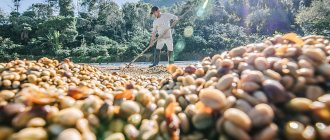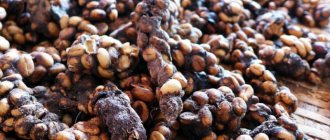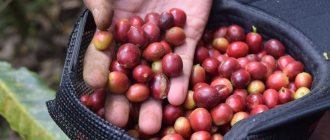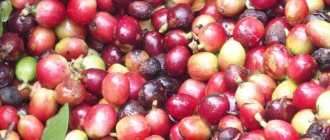History of plantation formation
There are two explanations for the introduction of coffee to Kenya. According to one version, in 1893, religious educators of the Holy Spirit community brought the first seedlings of this plant from Reunion Island. Coffee came to this island from Yemen at the beginning of the 18th century.
Young trees delivered by sea were planted near the capital of Kenya, Nairobi. Thus, this first agricultural enterprise became the basis for the development of the coffee industry.
The second version is based on historical documents, which say that the British began growing coffee trees on plantations in 1900. They grew wild in Ethiopia, the grains were brought by missionaries.
For decades, Britain had a monopoly on coffee plantations, which led to a popular uprising in the mid-20th century. After independence, all coffee businesses became the main industry in the country's economy.
Currently, there is a Coffee Department in Nairobi, whose main task is to control coffee production throughout the Republic of Kenya.
Coffee is sold at auction
In Kenya, coffee is sold through a national auction system. The coffee is put up for auction on behalf of the cooperative by marketing agents. The main buyers are large multinational companies, which then resell the lots to importers and roasters. Unfortunately, for a long time this was the only way to buy Kenyan coffee. This system was unstable, complex and completely opaque.
Recently, fortunately, positive changes have been taking place. Small importers, and sometimes roasters themselves, began buying coffee directly from auctions.
This not only helps support local, Kenyan businesses, but also makes the supply chain more stable and communication clear and efficient.
Labeling of coffee drinks
High mountain plains formed as a result of volcanic eruptions and unique natural conditions contributed to the cultivation of Kenyan coffee varieties. Thanks to their taste, they began to be considered elite and gained worldwide fame.
All grains of the Kenyan product are marked with letter combinations. For example, there is Kenya AA coffee beans. What does it mean?
The fruits of the coffee tree, marked with the “AA” sign, are oblong beans. Thanks to them, Kenya AA coffee beans are obtained with a delicate sour taste.
The large, round beans from coffee trees that grow only in Kenya are labeled "AB" and are characterized by a persistent aroma along with a fruity, citrusy flavor.
What is Kenyan coffee beans famous for?
Coffee plantations are located in the highlands of Kenya. Due to this, the fruits of the trees have bright acidity, characteristic of premium Arabica beans. Kenyan coffee is valued for its taste and aroma. When the drink is brewed correctly, the grains reveal their maximum flavor with subtle wine and fruit notes. Some varieties are distinguished by the presence of cane sugar flavor. The aroma of the product is rich, enveloping with fruit and berry notes.
High quality causes an increase in demand in the external market. Coffee accounts for 26% of the value of all goods exported from the country.
Among the main producers of Kenyan coffee are:
- Blues brand;
- Malongo Kenya;
- Molinari Riserva;
- Safari coffee Kenya Kilimanjaro.
Ruiruiru Coffee
Ruiruiru bean coffee from Kenya is considered unique among gourmets. Its peculiarity is that the first sips seem sweet, and then a characteristic bitterness begins to be felt.
The taste of this type of coffee from Kenya depends on the heat treatment of the beans. The higher the roasting temperature, the more pronounced the cherry and chocolate flavors of the drink. Notably, Ruiruiru does not have a sour taste.
The popular Kenya AA Ruiruiru coffee variety grows on the southern slopes of Mount Kilimanjaro. This drink in its finished form has a bready taste. Often these roasted and ground beans are added to coffee blends to improve the taste.
A distinctive feature of the drink, which is brewed from beans of the Ruiruiru variety, is that the aroma of the drink changes over time. For example, you start drinking and it seems to you that the taste of the drink is sweet, there is a caramel aftertaste. But when you drink about half a cup of coffee, it will already taste bitter.
Let's go through the regions
If you analyze all the types, varieties and mixtures that the African continent offers to black coffee lovers, it turns out that the choice is so large that it is simply impossible to choose one or two favorite drinks.
For those who want to try “coffee with character,” experts advise paying attention to Arabica from Burundi, which is distinguished not only by good strength and acidity, but also by an original aftertaste. But probably the most striking feature that attracts admirers from all over the world to Arabica from Burundi is its indescribable aroma. Chocolate notes are clearly audible in the aroma and taste, which will make any gourmet an admirer of this particular product. This type of coffee grows on high mountain plantations, which immediately affects its rich, but at the same time delicate taste and sourness. Despite the fact that coffee production in Burundi began only in the last century, the country managed to develop production and put it at a professional level, thanks to which the raw material is today considered the main export product.
There are seven quality grades of coffee beans from Burundi, ranging from group AAA to group BBB. At the same time, the AA and AAA product are an excellent example of ideal coffee, while BB class beans and others are perfect for mixing.
For those who appreciate the aroma of the drink, experts advise trying fruits grown in Zambia. This drink is positioned not just as a savory treat, but also as a healing one. The taste characteristics clearly show the taste of tangerine peel. But the aftertaste of this coffee is even more original, as it surprises with caramel and evokes associations with wild nature. As experts say, only black coffee from Africa can remind you of wild nature. Gourmets appreciate coffee brought from Zambia for its enveloping and long-lasting aftertaste.
Zambian Arabica, marked with the letters RV, is a special variety that is positioned as exotic, and which surprises with its wine-like acidity and astringent aftertaste. Even non-gourmets can feel the taste of cherry and chocolate from the first sip, which at the same time gives off an apple scent and freshness. The unique aftertaste and persistent aroma of coffee are what made Zambian Arabica RV so popular and widely purchased.
But Arabica from Zimbabwe will delight connoisseurs of floral scents and original flavors. The fruits have a distinct taste of spices, wine and berry undertones and sweet caramel, which does not drown out the light sourness. The fruity aftertaste mixed with bitter chocolate gives the fruit even more value. But perhaps the most unique feature of Arabica beans grown in Zimbabwe is the peppery flavor that is clearly visible in this chocolate, caramel and floral bouquet. Coffee connoisseurs love Zimbabwe Arabica, which is considered one of the best on the African continent, for its luxurious aroma and very delicate taste.
But Arabica RV (produced in Zimbabwe) will delight you with the rich flavor of apricots, prunes and floral undertones, which give this coffee-fruit cocktail a special originality.
Malawi Malanga is an Arabica that surprises with a rich fruity bouquet, in which notes of tangerines are especially clearly heard. Despite the presence of a certain astringency in the taste characteristics, coffee pleases with delicate floral undertones and a special sourness, which is characteristic only of African varieties of beans. In addition to the taste of tangerine, you can feel the taste of green apple, and the aftertaste will give you long-lasting pleasure and surprise you with notes of vanilla. The drink for which this coffee is used turns out rich, but weak, oily and smells very beautiful.
Rwanda presented connoisseurs with a special variation on the theme of Arabica, the aroma of which is reminiscent of the smell of fresh bread mixed with the smell of milk chocolate. The fruity aftertaste gives the drink even more originality, both in terms of taste and smell.
The fruits, which grow in Tanzania and are grown in the high-altitude tropical forests located on the mountain slopes of Kilimanjaro, surprise with a rich and refined taste that is similar to Kenyan coffee, but with less sourness. Moderate taste and at the same time luxurious aroma are the features that distinguish Tanzanian Arabica from raw materials produced in other African countries. At the same time, at the initial stage, the crop is processed using the “wet method”. As a result, coffee is excellent both in its pure form and in expensive high-quality blends.
Arabica from Tanzania, marked with the letters PB, will surprise you with the combination of the taste of almond oil and brandy, the smell of apricot and a slight bitterness in the aftertaste. This is probably one of the few drinks that, as it cools, becomes even more refined and acquires new properties in the form of a sweetish jasmine flavor.
But Ugandan Arabica attracts connoisseurs of wine tones in their favorite drink. Uganda Bugishu is also somewhat similar to Kenyan coffee, but at the same time it is much lighter and not so complex in its taste parameters. The aftertaste of coffee surprises with nutty shades and light sourness. By the way, this type of Arabica is very often used to prepare caffeine-free mixtures in their composition.
Return to content
Bourbon drink. What does it represent?
Bourbon coffee from Kenya is considered one of the most popular in Europe. The drink is made from fruits that have accumulated their taste over the centuries.
Six seedlings of this tree were brought from Yemen to France at the beginning of the 18th century and planted on the island of Bourbon (modern name "Reunion").
After some time, the young trees were transported to Brazil, and coffee plantations were created on its territory, which still exist today.
This variety is also grown on coffee plantations in Kenya. Bourbon Select-a-Vantage Kenya instant coffee drink, based on beans of this variety, is a unique combination of aroma and rich taste.
The advantages of this variety are its balanced composition, light coffee bitterness and wine-fruit aroma. The unique taste of Bourbon beans is obtained due to the fact that the product dries on the branches of the coffee tree. Plantations of this variety are few in number; harvesting is done only by hand. Therefore, the price of this drink is high.
Bourbon varieties. Description of species
There are several varieties of it:
- Yellow Bourbon is considered a rare type of coffee. Its peculiarity lies in the thin skin of the berries. Thanks to this, the grains absorb the warmth of the African sun's rays.
- The fruits of Bourbon Santos are harvested from trees no more than four years old. The grains are relatively small and have a deformed appearance. Their value lies in their distinct taste.
- The Bourbon Flat Bit Santos variety has a nutty flavor. These beans are harvested from the same trees as the Santos beans. The only difference is that the plant must be more than four years old. Due to this, the beans are large in size and have an oblong shape with a dark brown color.
- Bourbon Espresso is in demand now. This variety is made from various varieties of Bourbon grains. The peculiarity of this drink is the slow roasting of the beans, which gives it a pleasant coffee taste.
"Jardine" is a coffee from Kenya. Description of varieties and types
Jardine, which contains elite beans from coffee trees growing in Kenya, is considered a high-quality drink and one of the most popular among coffee fans.
This product is jointly produced by two and the Swiss Jardin Cafe Solution SA. As a result of a special production technology (double roasting of beans in a vacuum), “Jardin” retains the coffee smell and taste for a long time.
All packages indicate the strength of the drink in the form of numbers 3, 4 and 5. For lovers of a strong, rich taste, manufacturers recommend packaging with the number 4 or 5. The light aromatic drink is contained in packages with the number “3”.
Three varieties of this drink are considered the most popular. Jardin Dessert Cup coffee has a strong double roasting of beans (the number 5 on the pack) with a chocolate aroma. This variety is made from five types of Kenyan beans. Jardin All Day Long coffee has a medium roast (number 4).
For lovers of a soft drink, a package of Jardin Continental coffee with the number 3 is suitable. It contains a mixture of beans from two types of coffee trees, which are grown in Kenya and Colombia. Also popular is the Kenya Kilimanjaro Jardine Coffee.
Please note that the entire “Jardine” range is contained in hermetically sealed packaging. There are products presented in grains. Instant coffee “Jardine” from Kenya is also sold. Nowadays, many people prefer this type.
Coffee consumption per capita in different countries of the world
Per capita coffee consumption in Africa is low. On this continent, the leading coffee consumers are Ethiopia (2.27 kg), Madagascar (1 kg) and Côte d'Ivoire (0.9 kg). However, their performance is still significantly lower than other emerging markets such as Brazil (6 kg) and Algeria (3.2 kg). This is data from Ecobank. And in EU countries they consume about 9 kg per person.
But this is changing over time, with the region's emerging, urban middle class increasing coffee consumption locally.
This is evidenced by the growing presence of a chain of local coffee shops: Art Cafe in Kenya (partly owned by local coffee roaster Dorman's) and Java House, cafes in Nigeria (Café Neo) and Ethiopia (Café Kaldi).
Countries including Burundi, Kenya, Rwanda, Malawi, Tanzania, Zambia and most recently the Democratic Republic of Congo have already established export markets.
Each country's coffee has its own distinctive characteristics, making it accessible to all tastes.
Interestingly, with the exception of Ethiopia, very few Africans actually drink coffee. In many African countries, especially Kenya and Uganda, tea drinking is prevalent.
Let's take a deep dive into one of these African coffee-producing countries to learn a little about their coffee growing history and what it has to offer.
coffee cherries
Coffee recipe
Lovers of the coffee drink to improve digestion, appetite, and for colds offer coffee made from beans from Kenya, which includes red pepper. To do this, you need to prepare 2 teaspoons of any Kenyan beans, 100 grams of water, half a teaspoon of butter, a pinch of salt and red pepper, and the amount of sugar to taste.
Ground coffee beans should be poured into a Turk and fried over low heat. Then add water, sugar and bring to a boil. After this, add spices, oil, mix thoroughly and bring to a boil again. The prepared drink should be drunk in small sips from a preheated cup.










